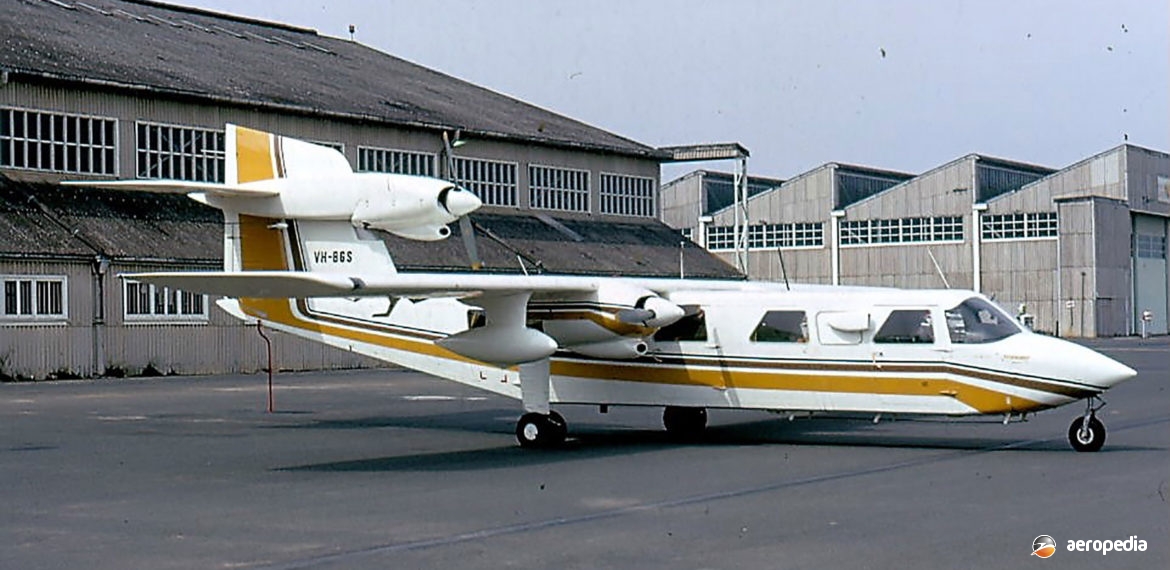Photograph:
Britten Norman BN-2A Mk III Trislander VH-BGS (c/n 322) at Bankstown, NSW in September 1973 (David C Eyre)
Country of origin:
United Kingdom
Description:
Charter and commuter airliner
Power Plant:
Three 194 kw (260 hp) Lycoming O-540-E4C5 six-cylinder horizontally-opposed air-cooled engines
Specifications:
- Wingspan: 16.25 m (53 ft)
- Length: 13.34 m (43 ft 9 in)
- Length with extended nose: 14.48 m (47 ft 6 in)
- Height: 4.11 m (13 ft 5¾ in)
- Wing area: 31.25 m² (337 sq ft)
- Max speed at sea level: 294 km/h (183 mph)
- Max cruising speed at 2,750 (9,000 ft): 280 km/h (174 mph)
- Economical cruising speed at 3,960 m (13,000 ft): 270 km/h (168 mph)
- Initial rate of climb: 299 m/min (900 ft/min)
- Range with max fuel: 1,384 km (860 miles)
- Empty weight: 2,800 kg (6,178 lb)
- Max payload: 1,610 kg (3,550 lb)
- Loaded weight: 4,536 kg (10,000 lb)
History:
The Britten Norman Trislander was developed from the twin-engine Britten Norman Islander, and had the same fuselage cross-section and mainplane. However, the fuselage length and wingspan were increased, and a third engine of the same type was installed on top of the fin. Development began in 1968 when an extended fuselage Islander was test flown.
The actual prototype of the Trislander G-ATWU (c/n 2) flew for the first time on 11 September 1970, the development prototype G-AYTU (c/n 245) following in May 1971. After some modifications to the tail, and American and British certification, production commenced alongside the Islander at Bembridge on the Isle of Wight, but later was transferred to Gosselies in Belgium in 1973.
The first Trislanders were known as the BN-2A Mk III with a loaded weight of 4,245 kg (9,350 lb), but this was increased to 4,540 kg (10,000 lb) in the BN-2A Mk III-1. The BN-2S with a lengthened nose flew for the first time on 18 August 1974, and this feature became standard on the BN-2A Mk III-2.
Only a small number of Trislanders have been imported to this region. First operators were Bush Pilots Airways operating out of Cairns in northern Queensland, and Country Air also in Queensland. SAFE Airways in Sydney, NSW used VH-BSG (c/n 279) for a period on commuter services from Cessnock to Sydney, and Eagle Airways of Bankstown, NSW operated VH-EGU (c/n 1030) on regular freight services until it was lost in the Snowy Mountains early in 1981.
Trislanders seen in Australia have included: VH-BGS (c/n 322) which went to New Guinea for a period as P2-DNX and later became VH-MRJ in May 1995; VH-BPH (c/n C.1003) which was withdrawn from service in 1983; VH-BSG (c/n 279) which crashed landing at Annanberg, New Guinea on 17 November 1980; VH-BSP (c/n 372) which was sold to the United States as N38535 in 1983 and later became P2-DNP; and VH–BPB (c/n 1025) which was sold in the USA as N3850K in 1982.
In 1986 the type became extinct in Australasia, the survivors being sold overseas. Production stopped in 1994, the last aircraft being delivered to the Botswana Defence Force in September 1984.
During 1989 Wellington, New Zealand, based Cook Straight Skyferry announced it was importing two model BN-2A-III-3 Trislanders and these aircraft (c/ns 1025 and 1039) became ZK-SFF and ZK-SFG. However, they were both withdrawn from service in 1993 and sold overseas.
In March 1990 another Trislander (c/n 381) arrived in Western Australia where, as VH-NKW, it entered service on geophysical work; and in 1993 VH-BSP entered service with Cape York Air Services in Cairns.
In the early 1990s a company known as Audrey Promotions announced it had obtained twelve incomplete Trislanders from the closed Romanian production line which had been held in storage. These were to be completed at Camden, NSW and sold overseas when assembled by Fixed and Rotary Wing Engineering, and were to incorporate a Pilatus Britten-Norman modification to extend the wing spar life. PBN held manufacturing rights, and a licence to build was held by International Aviation in the United States.
In 1993 Audrey Promotions indicated it planned to fit a Trislander with 403 kw (540 hp) V-8 converted motor vehicle engines with a view to reducing fuel consumption, increasing cruise and climbing speeds, and providing better field performance, but in the event none was completed. Subsequently these twelve aircraft were stored at Port Macquarie, NSW. Since then a few examples have been completed in the United States and it is believed the incomplete aircraft stored in Australia were exported there for completion.
In later times three Trislanders were imported by Great Barrier Airlines of Auckland, NZ these being ZK-LGC (c/n C381 – ex VH-NKW, C-GNKW, G-BCJW), ZK-LGR (c/n 372) and ZK-LOU (c/n 322 – ex VH-MRJ, P2-DNX, VH-BGS, DQ-FBY, G-BAFF, G51-322). These were operated for some years but ZK-LGC was withdrawn from service in 2008; ZK-LGR was scrapped in November 2002; and ZK-LOU was written off after an accident on 5 July 2009.
In 2003 BNG on the Isle of Wight announced it proposed to place the BN-2A Mk III Trislander back into production but this does not seem to have taken place.
In 2009 a further example was imported, a BN-2A-III Trislander YJ-0019 (ex G-BEPK, OE2, A2-AGY, Z-UTD, SX-CPG), which arrived in Gladstone, QLD in January that year for Unity Airlines, entering service in Vanuatu as YJ-0019.

